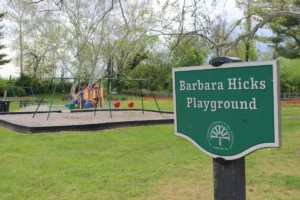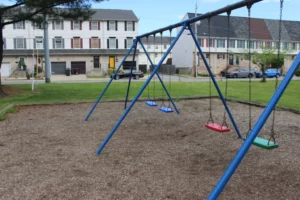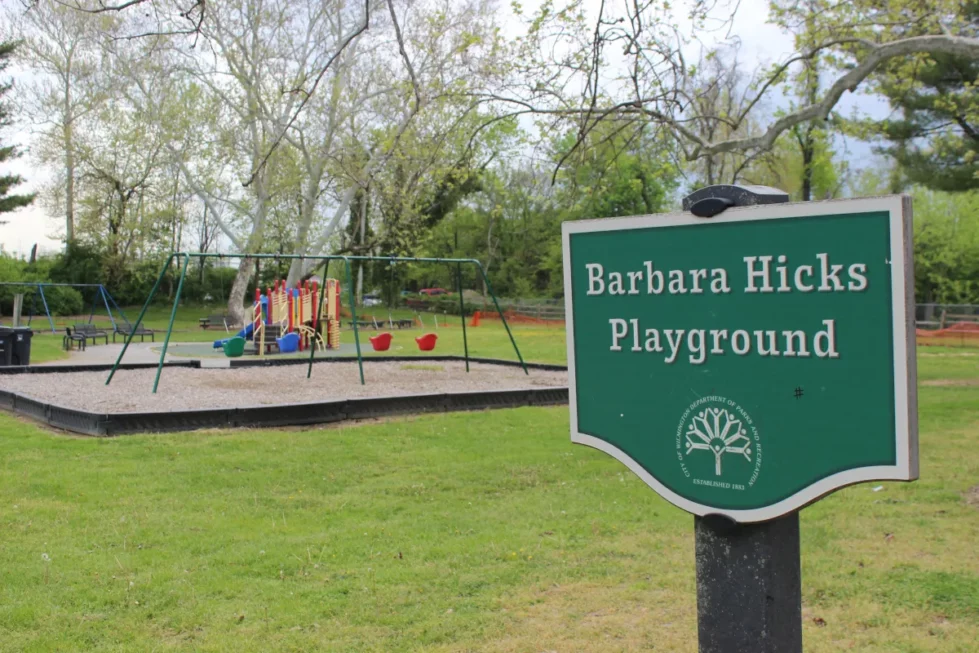
Barbara Hicks Park still awaits a remediation plan two years after the state’s environmental regulator discovered harmful chemicals in the soil. | SPOTLIGHT DELAWARE PHOTO BY JOSE IGNACIO CASTANEDA PEREZ
This story was originally published on Spotlight Delaware.
Regular visitors of Barbara Hicks Park in Wilmington’s Southbridge neighborhood face potential health risks stemming from contaminants in the soil that were discovered nearly two years ago. Despite the discovery, city officials have not yet made a decision on remedial action or established a timeline to clean up the park.
Frequent park visitors face risk of cancer-causing agents if they’re directly exposed to certain quantities of soil for extended periods of time, according to a Delaware Department of Natural Resources and Environmental Control (DNREC) investigation report.
The park’s soil contains elevated concentrations of polyaromatic hydrocarbons (PAHs) that generally have carcinogenic, or cancer-causing, effects. As one of the few green spaces that’s accessible to Southbridge residents, however, the park remains popular with locals.
 The low-lying neighborhood has long been plagued by perennial flooding and incessant mosquitos. It’s also one of seven New Castle County communities at greater risk for cancer and respiratory illness.
The low-lying neighborhood has long been plagued by perennial flooding and incessant mosquitos. It’s also one of seven New Castle County communities at greater risk for cancer and respiratory illness.
“Everybody that grew up with it is contaminated with whatever that is — all my kids,” said Rick King, a born-and-raised Southbridge resident, about the park contamination. “Dig it up and get it out of here and then let us move on.”
King recalled growing up in the neighborhood when the park used to just be a dirt mound with a basketball court and a couple swings.
Today, neighborhood residents often use the grassy park to play basketball, romp on the playground or swing on the pair of swing sets available. Community barbecues have also taken place at the space, which spans more than an acre.
Visitors enjoying outdoor activities at the park, who are directly exposed to shallow or deep soil, for 75 days a year may be exposed to contaminants of potential concern (COPCs), including chemicals, metals and glass, the report estimated.
Direct exposure includes inhalation, ingestion and touching.
“We were very concerned about the contamination, very concerned about residents having access to the park,” said Russell Zerbo, an advocate for the Clean Air Council, a Philadelphia-based environmental nonprofit.
Simply being at the park for 75 days a year, however, doesn’t “necessarily” mean a person would be at risk based on the exposure values calculated during the DNREC risk assessment report, according to Michael Globetti, DNREC media relations manager.
The estimation was in addition to children being exposed to 200 milligrams of soil per day and adults being exposed to 100 milligrams per day through inhalation, ingestion or touching. Only the ingestion pathway was found to pose “significant carcinogenic and non-carcinogenic” risk for the park visitor exposure scenario in the report.

Visitors to Barbara Hicks Park could be exposed to harmful chemicals should they inhale or ingest dust or dirt, according to an environmental report. | SPOTLIGHT DELAWARE PHOTO BY JOSE IGNACIO CASTANEDA PEREZ
Southbridge park soil content
The discovery of the contaminants was expected, as the metals and PAHs are typically found in urban environments that have had fill material or industrial uses, according to Globetti.
The soil contamination dates back to filling at the site that occurred between 1940 and 1965, according to Timothy Ratsep, director of DNREC’s Division of Waste and Hazardous Substances. The filling process is typical of low-lying properties in Wilmington, Ratsep added.
The contaminants were first discovered in June 2022 when a fence was being constructed along the southeast perimeter of the site. During the installation of fence posts, soil was brought to the surface that contained glass and ash, prompting the soil samples to be further tested.
The park’s soil consisted of 1 foot of silt and sand above roughly 4 feet of filling that contained brick, slag, coal, and glass fragments. Slag is a byproduct from smelting, welding or other steel manufacturing processes. Contaminants were found in shallow and deep soil at the park during the remedial investigation.
DNREC recommended remediation in order to prevent human exposure to contaminated soil at the site. The agency proposed either excavating the contaminated soil and disposing of it offsite and/or placing a 1-foot soil, stone or impervious cap over the impacted areas to restrict access to the underlying soil.
It was also recommended that an environmental covenant be implemented, which would restrict the site to non-residential use and prohibit land disturbance without prior written approval from DNREC, which issued the final plan of remedial action in February.
IN THE NEWS: Rep. Short: State needs budget oversight, just like hospitals are said to
City officials have not made a decision about which remediation approach to use, or whether to use a combination of both. The city also does not yet have a timeline for the remediation or redevelopment of the park, according to John Rago, deputy chief of staff for Wilmington Mayor Mike Purzycki.
“The timeline that will be followed is being determined through ongoing discussions among the City, its environmental consultant and DNREC,” Rago said in a written statement.
The remediation approach decision is part of the ongoing discussions, Rago added.
In 2017, Southbridge was identified as one of seven New Castle County communities that face “substantially higher” cancer risks in comparison to the largely white, affluent community of Greenville and to Delaware as a whole.
The affected communities face “substantial cumulative health risk” from their proximity to contaminated waste sites, polluting industrial facilities, hazardous chemical facilities as well as their exposure to toxic air pollution.
The residents of the identified communities were mostly low-income people of color, according to the report from the Union of Concerned Scientists, an advocacy nonprofit.
Southbridge had more than half of all brownfields in Delaware within a 1-mile radius, per the report. As of 2017, there were 48 brownfields, which are abandoned and contaminated sites of land.
Get stories like this delivered to your email inbox by signing up for the free newsletter at spotlightdelaware.org/subscribe.
Share this Post




